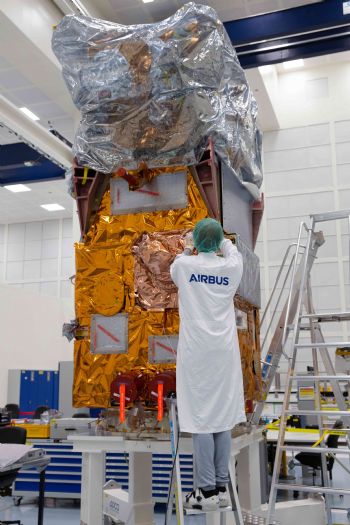 Airbus
Airbus has finished the integration of the Copernicus Sentinel-2C satellite in Toulouse. It is the third of its kind and will now be shipped to Munich to undergo extensive environmental tests to prove its readiness for space — a campaign that will last until March 2022.
The data gathered by Sentinel-2 satellites are used for monitoring land use and changes, soil sealing, land management, agriculture, forestry, natural disasters (floods, forest fires, landslides and erosion) and to assist humanitarian aid missions. Environmental observation in coastal areas likewise forms part of these activities, as does glacier, ice and snow monitoring.
Offering ‘colour vision’ for the Copernicus programme, Sentinel-2C – like its precursor satellites Sentinel-2A and -2B — will deliver optical images from the visible to short-wave infrared range of the electromagnetic spectrum. From an altitude of 786km, the 1.1 ton ‘C’ satellite will enable continuation of imaging in 13 spectral bands with a resolution of 10, 20 or 60m and a uniquely large swath width of 290km.
The telescope structure and the mirrors are made of silicon carbide, first pioneered by Airbus to provide very high optical stability and minimise thermo-elastic deformation, resulting in an excellent geometric image quality. This is unprecedented in this category of optical imagers. Each Sentinel-2 satellite collects 1.5 terabytes per day, after on-board compression.
The data is formatted at high speed and temporarily stored on board in the highest capacity mass memory and formatting unit currently flying in space. Data recording and laser-enabled downlink can take place simultaneously at high speed via the EDRS SpaceDataHighway, in addition to the direct X-band link to the ground stations.
Constellation of two identical satellitesThe Sentinel-2-mission is based on a constellation of two identical satellites, Sentinel-2A (launched 2015) and Sentinel-2B (launched 2017), flying in the same orbit but 180deg apart for optimal coverage and revisit time. The satellites orbit the Earth every 100min covering all of Earth’s land surfaces, large islands, inland and coastal waters every five days.
The satellites are currently sensing systematically all land and water areas, producing excellent results. Last year, the Sentinel-2 mission remained the top European mission in terms of peer-reviewed scientific publications (1,200 during 2020) and data volume distributed to users.
The Sentinel-2 mission has been made possible thanks to the close collaboration between
ESA, the European Commission, industry, service providers and data users. Its development has involved around 60 companies, led by Airbus Defence and Space in Germany for the satellites and Airbus Defence and Space in France for the multispectral instruments, while Airbus Defence and Space in Spain is responsible for the mechanical satellite structure.